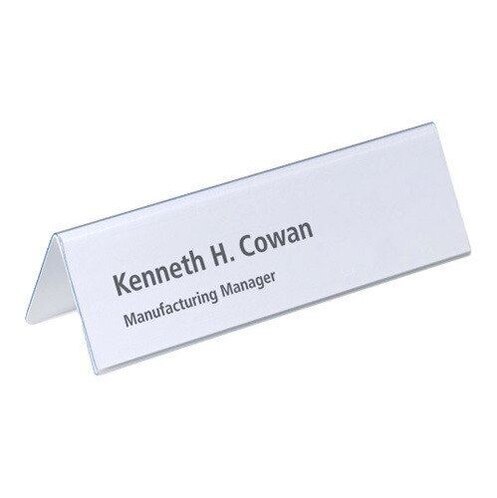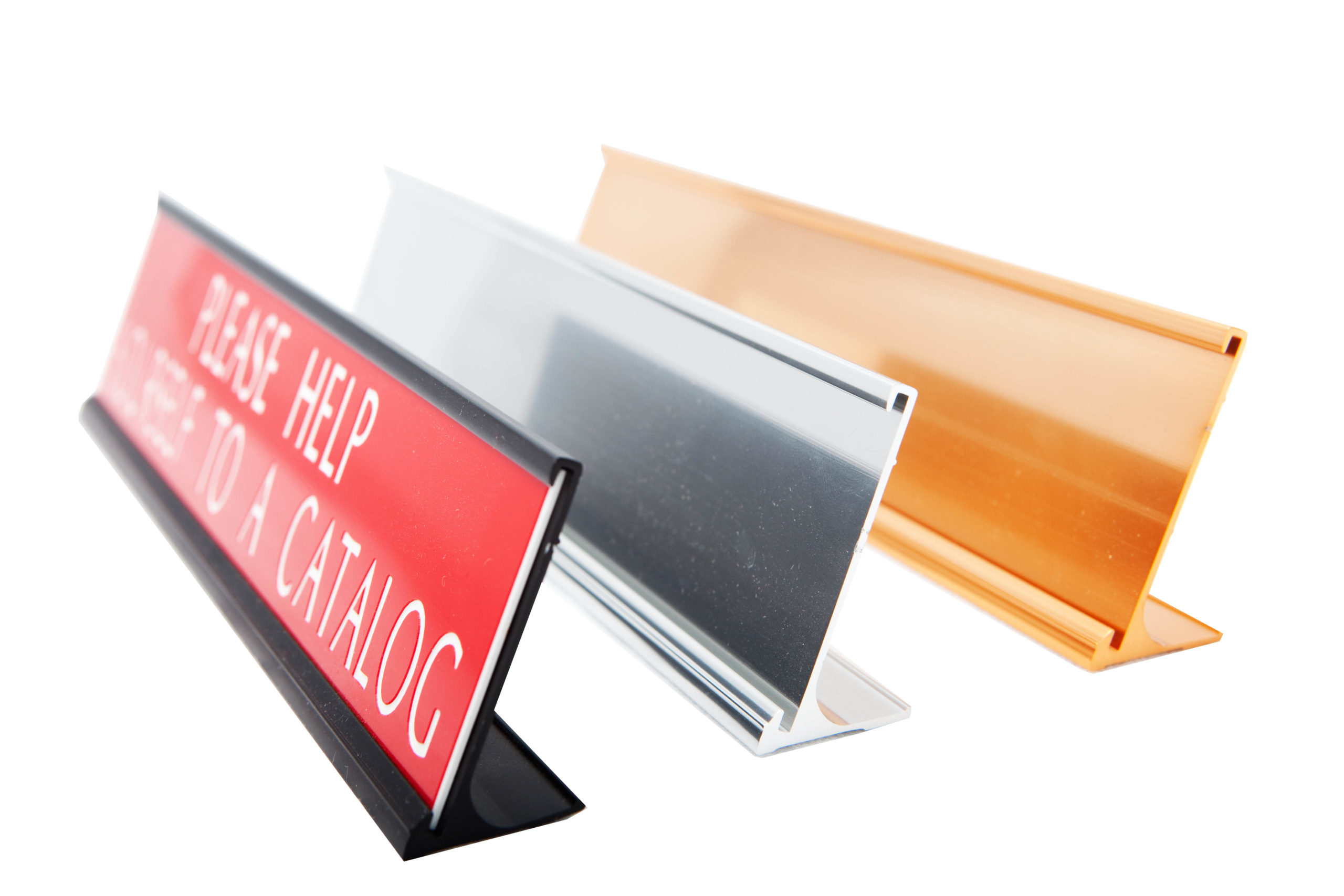Plastic Nameplates vs. Metal Alternatives: Which One Is Right for You?
How Plastic Nameplates Are Manufactured: A Comprehensive Guide to Their Production Refine
The production of plastic nameplates includes numerous precise steps, starting from the choice of suitable materials to the final finishing touches. Each phase is essential, guaranteeing the item satisfies specific needs for durability and aesthetics. Various production strategies play a considerable function in crafting these nameplates. Understanding these processes can clarify the intricacies behind what might feel like a straightforward product. What aspects add to the quality and modification of these nameplates?
Understanding Plastic Materials Used for Nameplates
,aspect=fit)
The Design Process: From Idea to Prototype
The layout process for plastic nameplates starts with a clear idea that guides the general development. Designers team up with clients to specify the function, design, and specific demands of the nameplate. This first stage consists of conceptualizing sessions, sketching concepts, and selecting shades and typefaces that line up with branding goals.Once the concept is established, designers use computer-aided style (CAD) software application to produce comprehensive digital depictions. These prototypes permit for visualization and modifications before moving on. Feedback from stakeholders is essential during this stage, as it assists refine the layout to meet expectations.After completing the electronic model, a physical design might be created, frequently through techniques like 3D printing. This concrete representation allows additional examination of aesthetics and functionality. In general, the style procedure is an essential action that lays the structure for the effective manufacturing of top quality plastic nameplates.
Reducing and Forming the Plastic
In the cutting and forming phase of plastic nameplate manufacturing, the option of products plays a necessary function in determining the end product's quality and longevity (Plastic Nameplates). Various accuracy reducing methods, such as laser cutting and CNC machining, assurance that the plastic is formed with precision and uniformity. This mix of cautious material choice and progressed reducing methods is crucial for creating top notch nameplates

Product Choice Refine
Choosing the ideal product is crucial for producing top notch plastic nameplates. Various kinds of plastics are readily available, each offering unique advantages and characteristics. Typical options consist of acrylic, polycarbonate, and PVC. Acrylic is favored for its clearness and UV resistance, making it suitable for exterior applications. Polycarbonate, understood for its resilience and effect resistance, is ideal for settings that require improved protection. PVC is commonly selected for its cost-effectiveness and adaptability in design. The selection procedure additionally takes into consideration factors such as surface area, thickness, and color coating, which can considerably affect the final look and performance of the nameplate. Ultimately, the chosen material should line up with the intended usage and aesthetic goals of the plastic nameplate.
Precision Cutting Methods
While picking the proper material lays the groundwork, accuracy reducing methods play a necessary duty fit the plastic nameplates right into their last types. Different approaches, consisting of laser cutting, CNC milling, and pass away cutting, are employed to accomplish precision and consistency. Laser cutting uses concentrated light to create detailed designs and clean edges, ideal for complex patterns. CNC milling uses convenience by getting rid of excess product with precision, accommodating various thicknesses and forms. Pass away cutting, on the other hand, allows for mass production of consistent items, enhancing efficiency. Each method is selected based upon the style requirements and the wanted coating, making certain that the end product meets quality standards and customer expectations while maintaining toughness and visual allure.
Printing Methods for Personalization
Just how can suppliers achieve vivid and exact designs on plastic nameplates? The response depends on different printing techniques tailored for customization. Digital printing has actually gained appeal as a result of its ability to create high-resolution pictures and intricate styles straight onto plastic surface areas. This technique enables fast turnaround times and marginal setup expenses, making it optimal for brief runs and customized orders.Screen printing continues to be another commonly utilized technique, particularly for larger quantities. It involves producing a pattern and using layers of ink, resulting in abundant colors and sturdiness. UV printing, which makes use of ultraviolet light to cure useful link the ink, is also reliable, giving outstanding bond and resistance to fading.Additionally, pad printing uses adaptability for irregularly designed nameplates, permitting thorough styles on tough surface areas. These printing methods make it possible for suppliers to fulfill varied customer needs while ensuring high quality and long life in their plastic nameplate items.
Surface Treatments and Finishing Options

Quality Assurance Steps in Production
Assuring the highest standards of quality assurance throughout the production of plastic nameplates is necessary for preserving item integrity and consumer complete satisfaction. Makers execute rigorous inspection procedures at numerous stages of the production procedure. Raw materials undertake complete screening to confirm they satisfy specifications for sturdiness and look at more info shade consistency. Throughout the molding phase, automated systems keep an eye on specifications such as temperature level and pressure to stop defects.In enhancement, aesthetic assessments are conducted to identify any surface area blemishes or imbalances. When the nameplates are generated, they are subjected to practical tests, including attachment tests for published components and stress tests for longevity. Quality assurance groups typically use statistical tasting methods to analyze batches, making certain that any deviations from criteria are immediately addressed. This in-depth method not only improves item high quality however likewise fosters count on with clients, affirming the maker's dedication to quality in every nameplate produced.
Product packaging and Circulation of Finished Nameplates
The packaging and circulation of ended up plastic nameplates are essential action in guaranteeing they get to consumers in ideal condition. Different packaging materials are picked to protect the nameplates throughout transportation, while delivering methods are very carefully chosen based on effectiveness and cost-effectiveness. In addition, efficient storage space services are carried out to keep high quality until the nameplates are provided.
Product Packaging Materials Used
Picking ideal product packaging materials is essential to assure their defense throughout transit when distributing ended up plastic nameplates. Typically utilized products include bubble wrap, foam extra padding, and cardboard boxes, all designed to support the nameplates against shocks and influences. Bubble wrap provides an adaptable obstacle, while foam padding guarantees that nameplates continue to be safely in location, reducing the risk of scratches or damage. Furthermore, sturdy cardboard boxes are made use of to consist of the nameplates, offering structural support and defense from exterior elements. Tags might be put on show taking care of instructions or breakable contents, additionally improving safety during transportation. Generally, making use of top quality product packaging materials substantially adds to the honesty and presentation of the ended up plastic nameplates upon arrival at their location.
Delivering Methods Utilized
Reliable distribution of ended up plastic nameplates depends on different delivery techniques that assure secure and timely shipment. Firms often make use of courier solutions, products shipping, and post offices, depending upon the size, weight, and location of the plans. For neighborhood shipments, copyright solutions give quick transportation, ensuring nameplates reach clients rapidly. For larger orders, products delivery is liked, making use of trucks or shipping containers to move mass amounts successfully. Postal services act as a cost-effective choice for smaller sized deliveries, specifically for residential distributions. All delivery techniques prioritize protective product packaging to avoid damages throughout transit. Tracking systems are likewise made use of to monitor shipments, providing clients with real-time updates and peace of mind pertaining to the condition of their orders.
Storage Space Solutions Implemented

Often Asked Questions
What Kinds Of Businesses Frequently Make Use Of Plastic Nameplates?
Plastic nameplates are commonly used by numerous services, consisting of workplaces, schools, factories, and healthcare facilities. These nameplates offer essential features such as identification, info display screen, and branding, adding to organizational performance and professional look across diverse settings.
How much time Does the Entire Manufacturing Refine Take?
The manufacturing process duration differs based on complexity and quantity, generally ranging from a couple of days to numerous weeks. Factors influencing this timeline include layout authorization, material accessibility, and production strategies used by the business.
Can Plastic Nameplates Be Recycled After Usage?
Plastic nameplates can be reused, supplied they are made from recyclable materials. However, the accessibility of recycling programs and neighborhood regulations might affect their recyclability. Correct disposal techniques are important to ensure effective recycling.
What Are the Environmental Effects of Plastic Nameplate Manufacturing?
The environmental impacts of plastic nameplate manufacturing include carbon discharges, source depletion, and pollution from making processes. Plastic Nameplates. Additionally, inappropriate disposal adds to plastic waste, detrimentally influencing ecological communities and wildlife, highlighting the demand for sustainable practices
Exist Any Type Of Security Interest In Plastic Nameplates?
Security worries regarding plastic nameplates primarily involve possible chemical exposure throughout production and the threat of materials weakening with time, which might cause unsafe substances being released, affecting both human health and the setting. While various products can be made use of for nameplates, plastic continues to be a prominent option due to its convenience and resilience. In the cutting and forming stage of plastic nameplate manufacturing, my company the selection of materials plays a vital role in determining the final item's high quality and resilience. Selecting the right product is crucial for generating premium plastic nameplates. While choosing the proper material lays the foundation, accuracy cutting methods play a necessary function in forming the plastic nameplates right into their final forms. When dispersing completed plastic nameplates, selecting appropriate packaging materials is essential to guarantee their protection throughout transportation.